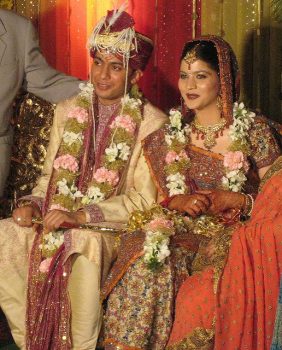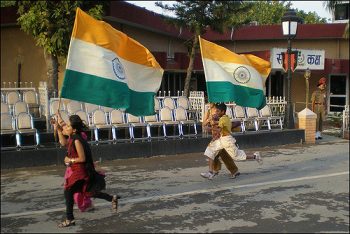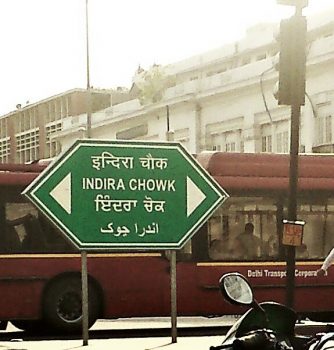Hindi ki Khichri Me Punjabi ‘Suaad’ Posted by Rachael on May 2, 2017 in Hindi Language, Uncategorized
As I’ve said before, Hindi is sometimes called a “khichdri bhasha,” (खिचड़ी भाषा, both words are feminine nouns) which basically means that it is a “mixed language” consisting of words, phrases and even sometimes grammatical structures from a variety of different languages. “Khichdri” (खिचड़ी, fem. noun) is a popular dish of ghee or clarified butter, cooked lentils, rice and spices that is simultaneously a “comfort food” as well as a dish often recommended for those suffering from digestive problems or other ailments; as it pertains to a language, “khichdi” (खिचड़ी) basically means that the language in question is composed of different elements, just as the dish is. Knowing the origin of words and phrases in Hindi can be a fascinating way to track this language and its speakers’ contact with various “visitors” and permanent settlers who traveled to North India throughout the centuries. Some of the languages that can be detected within Hindi words, phrases and grammatical structures are the following: Persian, Arabic, Turkish, Portuguese, Sanskrit, Prakrit and, of course, English.
But, in this blog, I want to talk about a very particular South Asian language that has touched Hindi, especially as it is spoken in and around the Indian capital city of New Delhi, in an indelible way. That’s right, I’m talking about Punjabi (पंजाबी, fem. noun, as are all languages). The title of this blog, “हिंदी की खिचड़ी में पंजाबी सुआद” (Hindi ki khichri me Punjabi suaad, or svaad in Hindi) meaning “(A) Punjabi flavor in Hindi khichri,” should’ve given you a clue as to what this blog would be about 🙂 This language is part of the Indo-Aryan language group, just as Hindi is, and it is commonly spoken in both the Indian and Pakistani parts of Punjab (where it often written in Urdu or nastaliq script). There are a lot of stereotypes, some of them not favorable, about Punjabis and some “Shuddh Hindivale” (शुद्ध हिंदी वाले, or proponents of shuddh/शुद्ध or pure, i.e. Sanksritized, Hindi) would argue that Punjabis have “corrupted” Sanskritized Hindi by injecting it with their own particular flavor. But, in this blog, we’ll try to forget all of that and talk about all the ways in which this fascinating language has positively influenced its sister, Hindi.
If you find yourself in New Delhi (commonly just referred to as Delhi or, in Hindi and Punjabi, दिल्ली), you may hear quite a bit of Punjabi or Punjabi-inflected Hindi because of the large number of Punjabis who live there. They will most likely appreciate it if you know a few words and phrases in Punjabi as well as in Hindi or at least appreciate the striking resemblance between the two languages:
Da/de/di (दा/दे/दी): the Punjabi equivalents of ka/ke/ki (का/के/की or possessive particles in Hindi; there is a separate form for feminine plural in Punjabi, but you most likely will not need to know that). Here are some examples of this:
- पिंकी हमारे परिवार दा (का) सदस्य हो गयी है/Pinky humaare parivaar daa (kaa) sadasya ho gayi hai । Pinky has become a member of our family.
*If you’re going to talk about Hinglish, which is a combination of Hindi and English, you can’t forget “Pinglish,” a combination of Punjabi and English; here’s a good example of it in an actual Punjabi song title: “Family दी Member” (from the Punjabi film, अँग्रेज/Angrej).
- वह हमारे भाई दी (की) girlfriend (गर्लफ़्रेन्ड) है / Voh humaare bhaai di (ki) girlfriend hai. She is our brother’s girlfriend.
- ये तुम्हारे हाथ दे/के पकोड़े (Punjabi: pakaurhaa, पकौड़ा) कमाल दे/के हैं ! /Ye tumhaare haath de/ke pakore (Punj: pakaure) kamaal de/ke hain! These pakoras you’ve made are amazing!
Pind (पिंड): a very important word, if not essential! It means a village.
- कभी कभी (मुझे) अपने पिंड की बहुत याद आती है । / Kabhi kabhi (mujhe) apne pind ki bahut yaad aati hai. Sometimes I miss my village a lot.
*variations: village-like or of the village (पेंडू/pendoo), villager (पिंड वाला/pind vaalaa). Be careful how you use these terms, however, as they can carry a pejorative connotation of someone who is unsophisticated and simple (in a bad way).
Ainvayi (ऐंवयी): in Hindi, this would be translated as “yunh hi,” (यों ही) which has many meanings, including “just in this way, casually, simply, cursorily, by chance”; this is a notoriously difficult phrase to translate, so I will illustrate its possible meanings with a few examples:
- Q: तुम बाहर क्यों पढ़ रहे हो?/Tum baahar kyon par rahe ho? A: (मुझे) नहीं पता, ऐंवयी/यों ही । / (Mujhe) nahin pataa, ainvayi/yunh hi.
Q: Why are you reading outside? A: I don’t know, just because/just like that.
- आप तो ऐंवयी/यों ही नाराज़ हो जाते हैं |/ Aap to ainvayi/yunh hi naaraaz ho jaate hain.
You become/get angry just like that (you have a quick temper).
- “मैं बल्ब की ओर ऐंवयी/यों ही देखता चुपचाप इस तरह बैठा रहा जैसे सारी दुनिया से बेखबर होकर कोई गंभीर बात सोच रहा हूँ” / “Main bulb ki or ainvayi/yunh hi dekhtaa chupchaap is tarah baithaa rahaa jaise saari duniyaa bekhbar hokar koi gambheer baat soch rahaa huun.”
(From renowned Hindi author, Rajendra Yadav’s, सारा आकाश/Saaraa Aakaash/The Whole Sky). I remained seated, just (simply) silently staring at the bulb as if I were thinking about something serious, oblivious to the world.
Ik (इक): his can mean “a” in Punjabi but, in Hindi, can have the meanings of both “a” and can be a variation of एक (ek) or the number one. This is a useful word to know both for Punjabi and Hindi because it is often used in song lyrics to add a more melodious tone to the words.
- इक (एक) तूफ़ान आ गया है । / Ik (ek) toofaan aa gayaa hai. A storm has come.
Some Postpositions and Other Useful Words:
- विच (vich): in, equivalent to में/me in Hindi
- दे वास्ते (de vaaste): for, equivalent to के लिए/ke liye in Hindi
- दे पीछे (de piche): behind, equivalent to के पीछे/ke peeche in Hindi
- दे नाल (de naal): with, equivalent to के साथ/ke saath in Hindi
- कौण (kauṇ): who, equivalent to कौन/kaun in Hindi. But, there is an important difference here in pronunciation––whereas the Hindi कौन/kaun has a dental “n” at the end (meaning that the “n” is formed by placing the tip of your tongue against the back of your top, front teeth), the Punjabi “कौण/kauṇ” requires a retroflex “n” at the end, meaning that you curl your tongue farther back to touch your soft palate, leaving you with an R-inflected “n” sound.
*Other question words: what, की/ki or, in Hindi, क्या/kyaa, किथ्थे/kiththe or, in Hindi, कहाँ/kahaan, when, कदोण/kadoṇ or, in Hindi, कब/kab and why, किणु/kiṇu or, in Hindi, क्यों/kyoon
- चंगी (changee): good (अच्छा/accha)
- कुड़ी (kuree): girl (लड़की/larki in Hindi).
- मुंडा (mundaa): boy (लड़का/larkaa in Hindi).
- सुंदर (sundar): this is the same in Hindi or, you can say सोणी (soṇi, informal) or सोणे (soṇe, formal) to give more of a Punjabi flavor.
- मुख (mukh): this is the same in informal Hindi (but in Hindi it can mean both face and mouth). Or, in more standard Hindi, the equivalent of this is चेहरा/chehraa.
- वडा (vadaa): big or, in Hindi, बड़ा/baraa. You will notice a pattern with many adjectives from Hindi to Punjab: the initial “b” in Hindi is replaced with a “v” in Punjabi.
- वधाई/वधायी (vadhaayee): congratulations which, in Hindi, is बधाई (हो)/badhaayee ho.
- वधिया (vadheeyaa): of good quality or simple “great!” In Hindi, this is बढ़िया (bardhiyaa).
- लंगर (langar): community kitchen often found in Sikh temples (or गुरुद्वारा/gurudvaaraa) wherein members of the temple community take turns cooking meals for the entire community; these meals are free and usually very tasty.
- सत स्री अकाल (sat sree akaal): the all-important Sikh greeting which translates to “God is truth.” About 76% of India’s Sikhs live in Punjab, where they make up a 2/3 majority, but you still want to be careful not to assume that everyone is Sikh; common indicators include a turban (usually worn by men, who often sport long facial hair) and a steel bracelet or कड़ा/karaa worn by both women and men.
I thought it would be fun to feature a Punjabi song for a change, as the Hindi and Punjabi music and film industries feed into each other quite a lot. Listen to this song with a piece of paper and pen/pencil at hand so that you can note down any words that seem familiar from your knowledge of Hindi. This song is called “कुरता/kurtaa” (hey, there’s one!) from the aforementioned film अँग्रेज/Angrej and features actor and singer Amrinder Gill, who is incredibly popular amongst those in the know 😉 As a plus, one of the costars of this film is the पिंड/pind:

Build vocabulary, practice pronunciation, and more with Transparent Language Online. Available anytime, anywhere, on any device.







Comments:
Mridula:
क्या बात कुड़िये!!!!!! छा गए तुस्सी ते !!
बहुत वदिया लिखा है। क्या हिंदी क्या पंजाबी दोनो भाषाओं को अच्छे से बताया है !
मज़ा आ गया ।
I will be following your blog for more interesting facts ?????